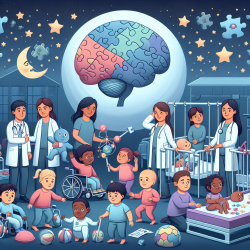Introduction
Globular Glial Tauopathy (GGT) is a rare and complex neurodegenerative disorder that presents unique challenges for speech-language pathologists (SLPs). The recent case study titled "Globular Glial Tauopathy Type I Presenting as Atypical Progressive Aphasia, With Comorbid Limbic-Predominant Age-Related TDP-43 Encephalopathy" provides valuable insights into the clinical manifestations and neuropathological underpinnings of this condition. Understanding these findings can significantly enhance the therapeutic approaches employed by SLPs, particularly in online therapy settings such as those provided by TinyEYE.
Key Findings from the Research
The study documents a case of atypical primary progressive aphasia (PPA) due to the coexistence of GGT and limbic-predominant age-related TDP-43 encephalopathy (LATE). The patient exhibited a spectrum of symptoms, including early nonfluent-agrammatical variant PPA, hippocampal amnesia, and late semantic variant PPA. This complex presentation underscores the need for SLPs to be aware of the diverse manifestations of GGT and the potential for mixed aphasia syndromes.
Implications for Speech-Language Pathologists
For practitioners, the study highlights several critical considerations:
- Comprehensive Assessment: The varied symptoms of GGT necessitate a thorough assessment of both language and cognitive functions. SLPs should be prepared to evaluate not only speech production and comprehension but also memory and executive functions.
- Interdisciplinary Approach: The case study emphasizes the importance of an interdisciplinary approach, involving neuropsychological, language-based, and neuroimaging assessments. Collaboration with neurologists, neuropsychologists, and other specialists can provide a more holistic understanding of the patient's condition.
- Customized Therapy Plans: Given the heterogeneity of GGT presentations, therapy plans must be tailored to the individual needs of the patient. SLPs should focus on maintaining functional communication skills and compensatory strategies to address both language and cognitive deficits.
- Continued Research and Education: As our understanding of GGT and related conditions evolves, SLPs must stay informed about the latest research findings. Engaging in continuous professional development and research can enhance clinical practice and improve patient outcomes.
Encouraging Further Research
The study of GGT and its impact on language and cognition is still in its infancy. SLPs are encouraged to contribute to the growing body of research by documenting their clinical experiences and outcomes. This can help refine therapeutic approaches and lead to better understanding and management of GGT and similar conditions.
Conclusion
The case study of Globular Glial Tauopathy Type I offers valuable insights for speech-language pathologists. By understanding the complex interplay of neuropathological factors and clinical symptoms, SLPs can enhance their therapeutic strategies and contribute to improved outcomes for individuals with progressive aphasia.
To read the original research paper, please follow this link: Globular Glial Tauopathy Type I Presenting as Atypical Progressive Aphasia, With Comorbid Limbic-Predominant Age-Related TDP-43 Encephalopathy.










